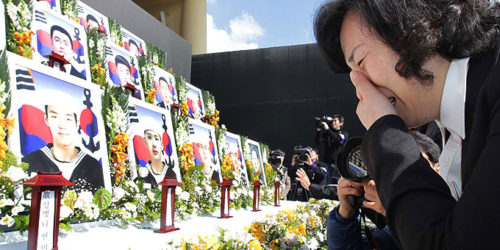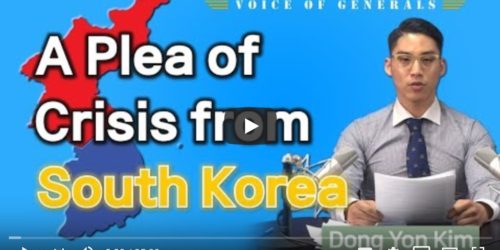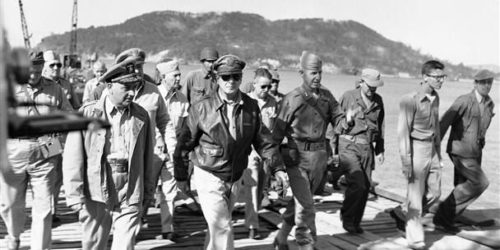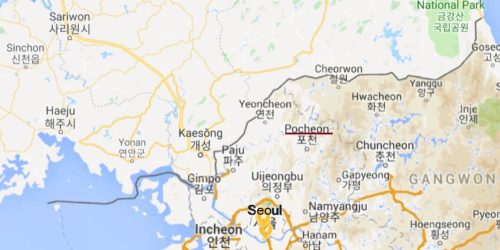Seoul Vulnerable: The Abandonment of the DMZ and the Destruction of South Korea’s Military Capability
Tara O, 2018-8-18
The Republic of Korea (ROK) unilaterally seeks to withdraw its troops from guard posts (GPs) inside the Demilitarized Zone (DMZ), citing the Moon-Kim joint declaration of April 27, 2018 of turning the DMZ into a “peace zone” in 5 days, which is by May 1, 2018. The problem is the North Korean threat has not dissipated. Its military is still forward postured, with 70% of its forces remaining near the DMZ. The infamous North Korean artillery that “will turn Seoul into a sea of fire” are still where they are. There are at least four tunnels discovered that North Korea dug into the South; there are probably more. Within the DMZ, North Korea has 160 GPs; South Korea has only 60 GPs (19:05). North Korea also has heavy weapons inside the DMZ, which were banned under the Armistice. North Korea has not made any declaration that it too will withdraw forces from the DMZ. Most importantly, North Korea has not changed its goal of dominating the entire peninsula under its rule.

The Ministry of Defense (MND) reported the plan to the National Assembly’s National Defense Committee on July 24, 2018. The withdrawal from the GPs are to be a “trial” before a full blown withdrawal of all troops from the forward area occurs. In 2007, then president Rho Moo-hyun (whose Chief of Staff was Moon Jae-in) sought the same–to remove guard posts from the DMZ. “Removing the guard posts means the withdrawal of soldiers and arms located inside the zone,” an official said, back then.
It is curious why the Moon Jae-in administration even bothers using the term “trial,” because the concept is not to say remove one GP and see, but rather removing all GPs outright. It seems to be a word play to confuse the situation and prevent people from understanding the situation.
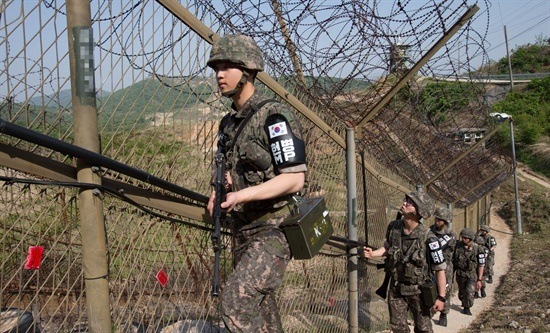
Even before talking about the DMZ withdrawal, the South Korean government already was reviewing plans to withdraw 98 positions in the forward area, which includes not only the DMZ, but areas south of it (5-10 km). That includes pulling back the K-9, a South Korean self-propelled 155mm Howitzer, which became known for counter fires into North Korea after North Korea shelled Yeonpyeong Island in 2010. The Moon administration also suspended the construction of facilities at these locations that were scheduled for this year or reflected in next year’s budget.
In the decision to pull back the forces from the forward area, there was a controversy over whether the military authorities included the most important focal points for North Korea–the Marine Corps 2nd Division (해병 제2사단) and the Army 7th Mechanized Infantry Corps (제7기동군단). It was initially reported that the MND was examining redeploying them to the rear area. The Marine Corps 2nd Division defends Gimpo City and west wards, including the Han River Estuary out to the West Sea and the 7th Mechanized Infantry Corps, with formidable firepower, is tasked with moving north in case of war. Needless to say, re-deploying them to the rear would leave the northern flank extremely vulnerable to North Korean attacks. After the story was released, the MND denied that those units were under consideration to be redeployed. However, in and out of the military, there are suspicions that the current government leaked the sensitive story to test people’s reactions.
Although the justification is the establishment of a “peace zone” per the April 2018 agreement, various measures unilaterally taken so far only indicate the Moon administration’s eagerness in exposing its flank and leaving Seoul, Incheon, and other areas vulnerable to an attack by North Korea, which still maintain the capability to attack, and its intentions have not changed.
What other measures were taken that weaken ROK national security? Here’s the list of events, many of which came from NewDaily.com, but also from other sources (not a complete list):
-April 17, 2018: Anti-tank fence begins to be demolished
In northern Gyeonggi Province, the demolition of the anti-tank barriers have begun. In Gangwon Province, the removal of the anti-tank barriers have been occurring for some time.
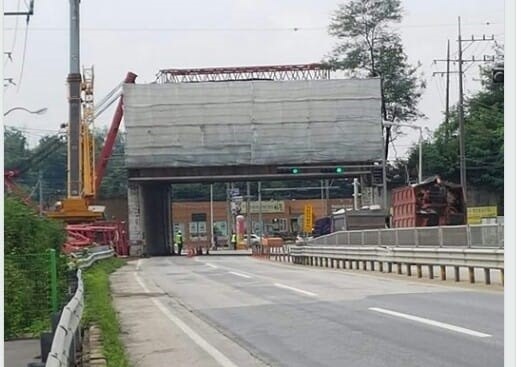
-April 23, 2018: Broadcasting of loudspeakers to North Korea stopped
The MND suspended the broadcasting of the loudspeakers in the DMZ, even before the April 27 Moon-Kim meeting. It was halted during the Sunshine policy period, but returned during the Park Geun-hye administration. North Korea had vehemently been opposed to South Korea’s loudspeaker broadcasts, even threatening to shoot the loudspeakers. Such a reaction indicates the Kim Jong-un regime fears the penetration of external information and views the loudspeakers as a formidable weapon.
-May 1, 2018: Loudspeakers in the DMZ removed
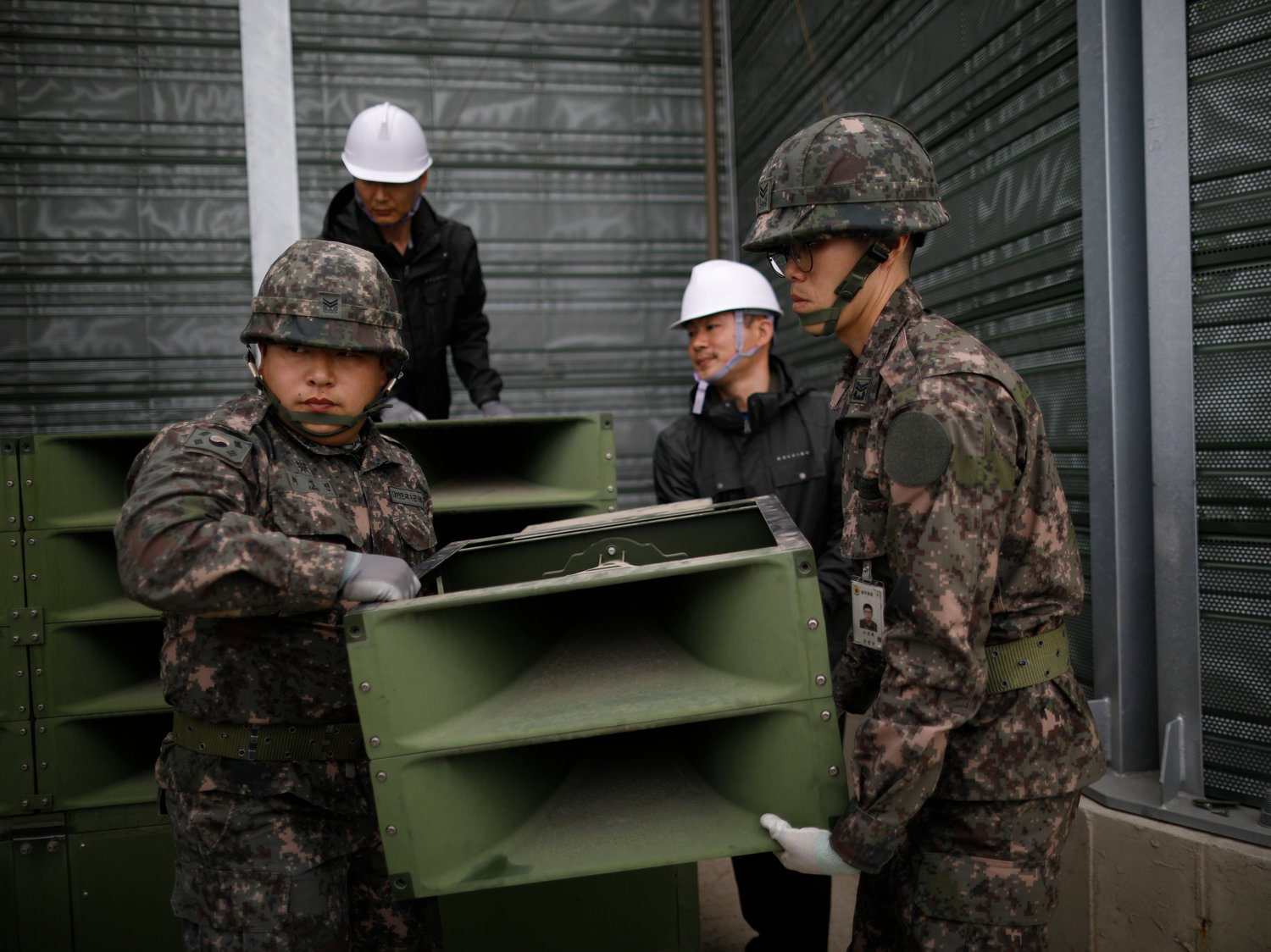
-May 13: The Loudspeaker capability disappears from South Korea
An Army colonel, the head of the loudspeaker manufacturer, and 18 others were indicted for “substandard loudspeakers.” Apparently, the investigators found the sound did not travel far enough. One has to wonder how they were able to make such a determination so soon after the removal of the speakers and how so many were indicted so quickly. There has been no news about this case prior to or after this indictment. These speakers are specially made and not everyone can make them. As such, the swift prosecution in effect eliminated the loudspeaker capability that has been particularly irksome to Kim Jong-un regime.
-June 14: Panmunjom disarmament settlement
After the Panmunjom Declaration, it was insisted that the NLL should be abolished to create the West Sea peace zone. South Korea and North Korea discussed this issue at the June 14 working-level talks.
-June 17: U.S.-ROK combined exercise tentatively halted
Moon Chung-in, the President’s Special Advisor for Foreign Affairs and National Security, said the ROK-U.S. combined exercises could stop if North Korea suspends its nuclear/missile testing–precisely what North Korea and China had been demanding. The U.S. and ROK declared the suspension of the combined military exercise Ulchi Freedom Guardian; however, North Korea has not stopped any of its military drills, including Han River crossing exercise.
-July 1: New Construction for the units at the DMZ Completely Deferred
The MND announced the suspension of the construction projects for the 90-100 military units in the front line area as well as new constructions, which were reflected in the budget. The reason given was to reduce the cost of demolition if the security situation changes due to the “progress” of inter-Korean relations.
-July 2: Review of ROK Military Capability and Industries
North Korea has not denuclearized and it still continues to conduct its annual exercises, but the Moon administration began a review of the next generation weapons capabilities currently in development against the North Korean threat. The investment for anti-missile systems, long range strike, and attack/transport helicopters have been reduced or halted.
-Tanks held are reduced from 2,400 to 1,700
-Increasing K-2 Black Panther Tanks from 100 to 200
-Significantly cut the budget of the CH-47 Chinook transport helicopter and AH-64D Longbow Apache attack helicopter, which has superior anti-tank capability
-July 4: Began demolishing coastal barbed wire
-East Coast: Have been removing the barbed wire for 12 years
-West Coast: Coastal wire demolition work is expected to begin soon.
-July 6: Withdrawal of the 98 units at the DMZ Review
Depending on the inter-Korean reconciliation atmosphere, the Moon administration is
considering a plan to completely withdraw 98 military units from the DMZ. The plan is to relocate units for the creation of a “peace zone” near the Military Demarcation Line.
-July 10: Suspended Ulchi military exercise
The Moon administration announced that it would temporarily suspend Ulji (alternate spelling: Eulji) training, in effect halting the exercise. The Ulji is an annual nationwide contingency readiness exercise to master the procedures for reviewing and supplementing measures for national emergencies such as wartime or disasters.
-July 10: Ordered the investigation of the Defense Security Command (DSC)
The DSC is a military organization that seeks out internal espionage and prevents subversive acts. The Deoburreo Minju Party and some in media have portrayed the DSC as “plotting a coup” against the “candlelight” demonstrators, when the DSC was in fact doing its job and they were not plotting a coup. It made a contingency plan for a martial law in case of a chaotic and violent situation after the constitutional court made a decision about the impeachment. DSC reported the plan’s existence to the Defense Minister Song, who reported to the Blue House on multiple occasions, yet the Blue House denied knowing it.
Moon ordered the investigation of the DSC while he was visiting India. The MND is reviewing the dismantlement of the DSC. There is a claim that Moon’s order to investigate the DSC is an order to dismantle it.
Moon has long called for the elimination of the National Intelligence Service (NIS). Since Moon became the president, the majority of the senior officials in charge at the NIS have been re-assigned elsewhere. It appears the same process will be applied to the DSC. There is already a limit to anti-North Korea/communist investigation and domestic counter-espionage capability. If DSC is reduced or dismantled, as was done to NIS, who will monitor and catch the North Korean agents and spies?
-July 25: Removing barbed wire fence by the Han River Estuary
The government announced the removal of 8.4 km of barbed wire metal fence in Goyang City, Gyeonggi Province to begin in October 2018 until June 2019.
The border forces in this area are to be withdrawn by the end of July 2018.
-July 30: Government announced defense reform, cutting 118,000 ground troops by 2022
-Cut 118,000 troops from 618,000 to 500,000
(All the cuts are from the Army, from 483,000 to 365,000)
-Shorten draft from 21 months to 18 months for Army
–Cut general officers by 17%, from 436 to 360, mostly from the Army
(66 from the Army, 5 from the Air Force, 5 from Navy)
-Increase civilian staff from 5% to 10%
-Cut 6 Army divisions, from 39 to 33
(The front line divisions will be cut from 11 to 9.)
-Moon discarded a plan to seize the Pyongyang in 2 weeks in case of a war
-August 3: Moon ordered the dismantlement of the DSC
While on vacation, Moon ordered DSC’s dismantlement and the creation of a brand new headquarters completely severed from its past with 30% less personnel. Moon named Lieutenant General Nam Young-shin (남영신), formerly the Special Operations Command commander as the new commander.
-August 16: MND announced the removal of sea/river boundary iron fence
-Remove 300 km of defensive iron fence.
-Dismantle military facility protection areas
-The MND also announced it will privatize the the management of housing facilities and integrate management by region. Currently, the unit’s soldiers and civil servants directly manage their housing.
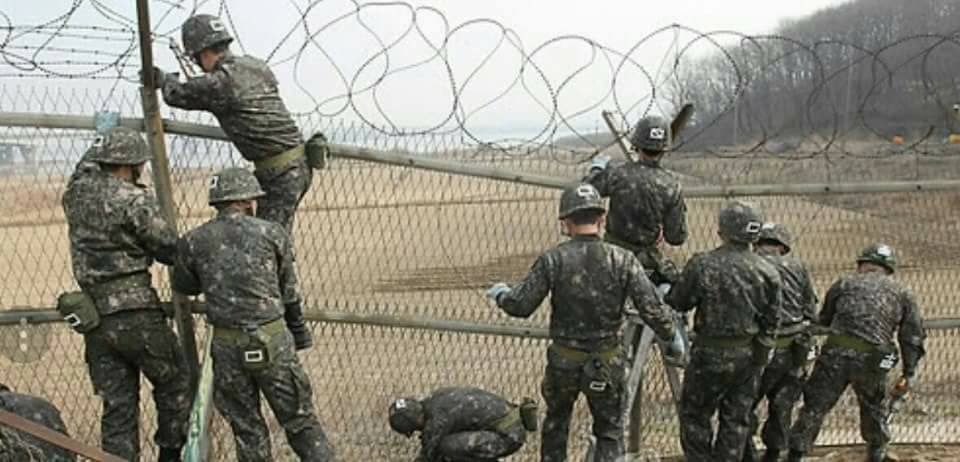
Other related issues:
-Review/cut budget for Interceptors/Missiles to respond to NK missile threat
The possibility of mass production of a tactical ground-based guided missile capable of immediate retaliation to North Korea attack has become very low.
-Cheolmae-2 (철매-2): Reviewing Cheolmae-2 medium range Surface-to-Air interceptor program
-Hyunmoo-2C (현무-2C): 현무-2C is a South Korean short range ballistic missile that is part of the “Kill Chain” to respond to North Korean missile threat. The investment in Hyunmoo-2C has been greatly reduced.
-Hyunmoo-4 (현무-4): It is a long-range ballistic missile capable of destroying North Korea’s underground military facilities, command centers and its leadership. The MND is reviewing the program.
-The defense / retaliation capabilities against North Korean missile threat as well as hundreds of billions of won in the development cost are lost.
-Military Human Rights Center, an NGO headed by Lim Tae-hoon (임태훈) influencing MND
Lim, a civilian (not a civil servant) who never served in the military, apparently calls and attends general officer-level meetings and influences military policy.
-Lim called for and attended the Military Service Policy Working Committee and scolded the general officers in attendance.
-Defense Minister Song chided his senior officers for not letting him know Lim wanted to hold the Military Deliberative Committee meeting (Joint Chief, Service Chiefs attend).
-Lim released DSC’s classified documents and called for DSC’s dismantlement.
-Lim threatened to sue Kim Kwan-jin, former National Security Advisor and Han Min-goo, former Defense Minister, both under the previous administration, for “plotting a rebellion.”
-Lim is an associate of Im Jong-seok, the Blue House Chief of staff
(More about Im Jong-seok here)
-Lim’s Military Human Rights Center is to receive $200,000 from Soros’ Open Society Fund
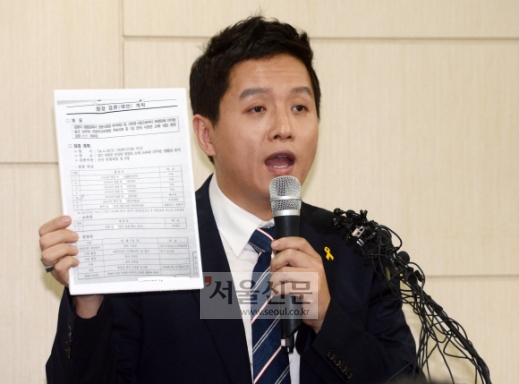
The Moon administration has made sweeping changes that significantly reduce the Republic of Korea’s defense capabilities, all in the name of “peace” and implementing the Panmunjom Declaration of April 27, 2018. The relevant parts of the declaration are below:
—–
2) South and North Korea will make joint efforts to alleviate the acute military tension and practically eliminate the danger of war on the Korean Peninsula. Alleviating the military tension and eliminating the danger of war is a highly significant challenge directly linked to the fate of the Korean people and also a vital task in guaranteeing their peaceful and stable lives.
- South and North Korea agreed to completely cease all hostile acts against each other in every domain, including land, air and sea, that are the source of military tension and conflict. In this vein, the two sides agreed to transform the demilitarized zone into a peace zone in a genuine sense by ceasing as of May 1 this year all hostile acts and eliminating their means, including broadcasting through loudspeakers and distribution of leaflets, in the areas along the Military Demarcation Line.
- South and North Korea agreed to devise a practical scheme to turn the areas around the Northern Limit Line in the West Sea into a maritime peace zone in order to prevent accidental military clashes and guarantee safe fishing activities.
- South and North Korea agreed to take various military measures to ensure active mutual cooperation, exchanges, visits and contacts. The two sides agreed to hold frequent meetings between military authorities, including the Defense Ministers Meeting, in order to immediately discuss and solve military issues that arise between them. In this regard, the two sides agreed to first convene military talks at the rank of general in May.
The declaration refers to reducing tensions and establishing peace zones, but again, the problem is that North Korea has not reduced its threat. Only the Moon administration has been vigorously pursuing the degradation of South Korea’s current and future defense posture and capabilities. With these whirlwind changes, South Korea is left extremely vulnerable to North Korea’s invasion, coercion and subversion.
